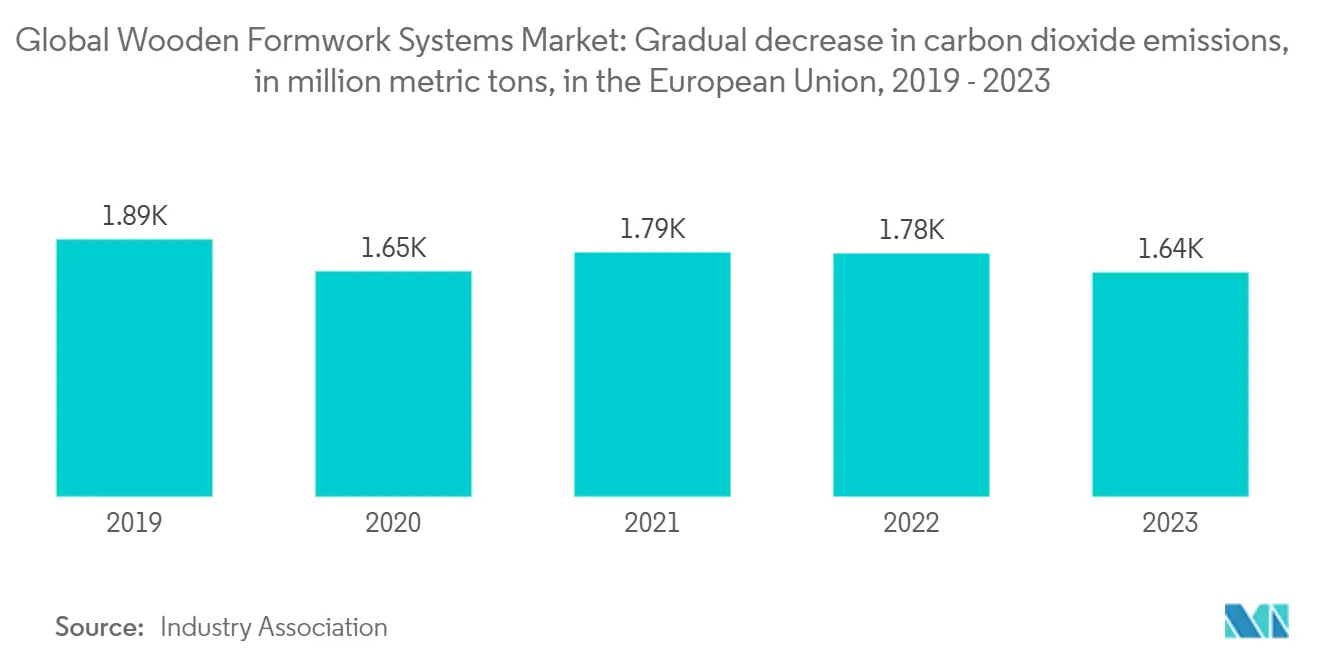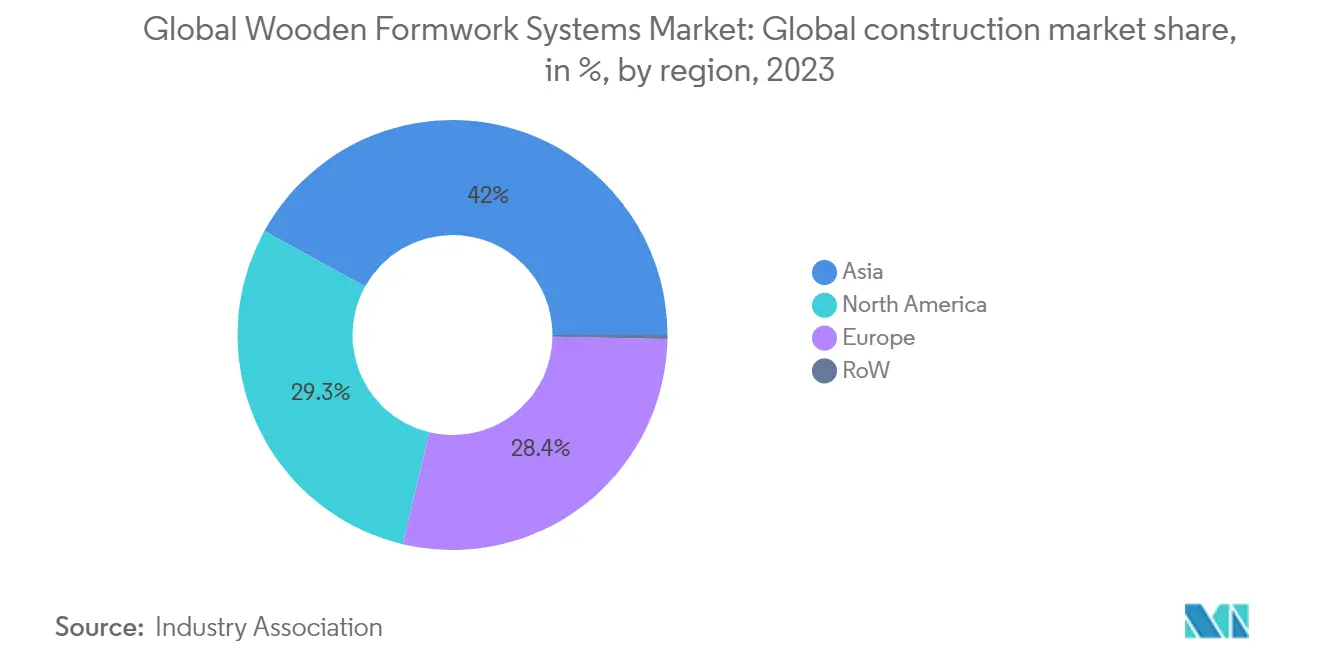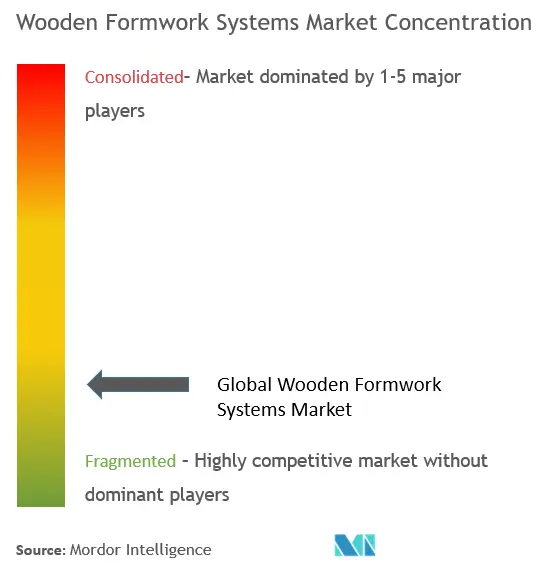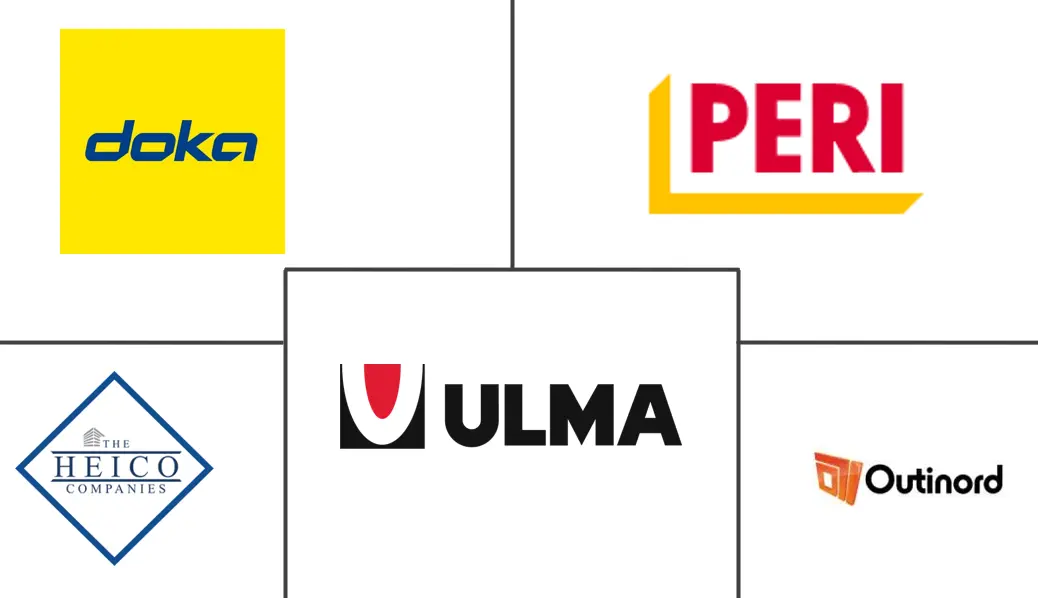Global Wooden Formwork Systems Market Size and Share

Global Wooden Formwork Systems Market Analysis by Mordor Intelligence
The Global Wooden Formwork Systems Market is expected to register a CAGR of 1% during the forecast period.
In recent years, the wooden formwork systems market has demonstrated substantial growth, primarily driven by the construction industry's increasing focus on sustainability and environmental responsibility. Wood, as a renewable and biodegradable material, provides a lower carbon footprint compared to alternatives such as steel or aluminum. This transition toward eco-friendly construction practices has resulted in greater adoption of wooden formwork systems across various projects.
Governments globally are recognizing the environmental advantages of wooden construction and are actively supporting initiatives to encourage its use. For example, in October 2024, Sweden initiated the development of 'Stockholm Wood City,' the largest urban development project worldwide constructed entirely from timber. This project, aimed at delivering 2,000 homes by 2027, reflects significant governmental efforts to promote sustainable building practices.
Technological advancements have further strengthened the market, with the integration of digital tools such as Building Information Modeling (BIM) and virtual reality (VR) optimizing formwork design and construction processes. Additionally, the adoption of automation and robotics in formwork installation has enhanced operational efficiency and reduced reliance on manual labor.
In conclusion, the wooden formwork systems market is on a growth trajectory, driven by environmental considerations, governmental support, and technological innovations. As the construction industry continues to prioritize sustainability, the demand for wooden formwork systems is expected to remain strong in the foreseeable future.
Global Wooden Formwork Systems Market Trends and Insights
Declining Carbon Emissions and the Rise of Sustainable Construction in Europe
European construction companies are increasingly adopting wooden formwork systems as part of their strategic efforts to enhance sustainability and reduce carbon emissions. Wood, as a renewable resource, provides a lower embodied carbon footprint compared to traditional materials such as steel and concrete. This shift is driven by stringent regulatory frameworks and a growing focus on environmental responsibility within the sector.
In February 2025, the 14th edition of the International Wood Construction Forum took place at the Grand Palais in Paris, highlighting the rising importance of timber in sustainable construction practices. The event showcased innovative solutions and underscored wood's expanding role in modern construction methodologies.
Businesses are also allocating significant investments to align with this trend. For instance, Sonae Arauco announced in December 2024 an investment exceeding EUR 5 million (USD 5.17 million) to establish two new wood recycling centers in Portugal. This initiative aims to strengthen the integration of recycled wood into particleboard solutions, advancing the use of sustainable materials in the construction industry.
In summary, the European construction sector's focus on reducing carbon emissions is driving a substantial transition towards sustainable materials and practices. The increased adoption of wooden formwork systems, supported by regulatory measures and notable investments, reflects a broader industry movement towards environmentally responsible construction strategies.

The Rise in Construction Activities is Directly Fueling the Demand for Wooden Formwork Systems
The global building construction market is witnessing substantial growth as it approaches 2030, driving the demand for efficient construction solutions, including wooden formwork systems. In February 2025, Holcim announced plans to increase capital expenditure and pursue acquisitions to leverage the growing infrastructure demand in the United States, with a goal to achieve annual sales of USD 20 billion by 2030.
In Saudi Arabia, significant government investments in public infrastructure and transportation networks are accelerating construction activities. Furthermore, initiatives aimed at economic diversification and the promotion of non-oil sectors are bolstering the demand for formwork systems. Key projects under the Vision 2030 framework include NEOM, the Red Sea Project, Diriyah Gate, Qiddiya, the Regional Headquarter Programme, and the Shareek Programme.
India's construction industry recorded a 7.8% growth in real terms in 2024, supported by public and private sector investments in industrial and energy projects, as well as government spending on transport infrastructure.
In conclusion, the expanding global construction market is driving the adoption of wooden formwork systems. As the industry progresses towards 2030, the focus on efficient and sustainable formwork solutions is expected to create significant opportunities for the wooden formwork systems market.

Competitive Landscape
The global wooden formwork systems market is fragmented and highly competitive. Competition and pricing have increased strongly, and new investors and developers have entered the market. Moreover, both the demand and supply of wooden formwork are increasing. Some key players operating in the market include Doka, PERI, ULMA, Acro, The Heico Companies LLC, MEVA Systems Inc., etc. The increasing number of construction projects across the globe makes it easier for new players to enter the market. Still, these small players face fierce competition from established major players. The major players in the market mostly offer a wide range of products to have a competitive edge over other players. Start-ups try to break into the market with innovative products and technology integration.
Global Wooden Formwork Systems Industry Leaders
-
Doka
-
PERI
-
ULMA
-
ACROW
-
The Heico Companies LLC
- *Disclaimer: Major Players sorted in no particular order

Recent Industry Developments
- September 2024: PERI Group has allocated EUR 50 million (USD 51.56 million) to expand its production facilities in Germany, aiming to enhance the output of its wooden formwork systems. This investment is positioned to address the increasing demand for high-quality formwork solutions in domestic and international markets, reinforcing the company’s strategic focus on supporting the growth of the construction sector.
- March 2024: Doka has entered into a strategic partnership with a prominent European construction firm to develop advanced wooden formwork systems. These systems are engineered to enhance sustainability and operational efficiency in large-scale infrastructure projects. The collaboration prioritizes the integration of innovative designs and materials to minimize environmental impact and optimize construction processes.
Global Wooden Formwork Systems Market Report Scope
The wooden formwork is a temporary mold used in concrete constructions. It is the base structure used to develop the final framework of a building, which helps maintain shape and stability. The global market for wooden formwork systems is segmented by slide type (China fir, timber, pine wood, and ply wood), by application (buildings, transportation, and industrial facilities), and by geography (North America, Europe, Asia-Pacific, the Middle East, Africa, and the Rest of the World). The report offers market size and forecasts for the Global Wooden Formwork Systems Market in value (USD billion) for all the above segments.
| China Fir |
| Timber |
| Pine Wood |
| Plywood |
| Buildings |
| Transportation |
| Industrial Facilities |
| North America |
| Europe |
| Asia-Pacific |
| Middle-East and Africa |
| Rest of the World |
| By Slide Type | China Fir |
| Timber | |
| Pine Wood | |
| Plywood | |
| By Application | Buildings |
| Transportation | |
| Industrial Facilities | |
| By Geography | North America |
| Europe | |
| Asia-Pacific | |
| Middle-East and Africa | |
| Rest of the World |
Key Questions Answered in the Report
What is the current Global Wooden Formwork Systems Market size?
The Global Wooden Formwork Systems Market is projected to register a CAGR of 1% during the forecast period (2025-2030)
Who are the key players in Global Wooden Formwork Systems Market?
Doka, PERI, ULMA, ACROW and The Heico Companies LLC are the major companies operating in the Global Wooden Formwork Systems Market.
Which is the fastest growing region in Global Wooden Formwork Systems Market?
North America is estimated to grow at the highest CAGR over the forecast period (2025-2030).
Which region has the biggest share in Global Wooden Formwork Systems Market?
In 2025, the Asia-Pacific accounts for the largest market share in Global Wooden Formwork Systems Market.
What years does this Global Wooden Formwork Systems Market cover?
The report covers the Global Wooden Formwork Systems Market historical market size for years: 2019, 2020, 2021, 2022, 2023 and 2024. The report also forecasts the Global Wooden Formwork Systems Market size for years: 2025, 2026, 2027, 2028, 2029 and 2030.
Page last updated on:
Global Wooden Formwork Systems Market Report
Statistics for the 2025 Global Wooden Formwork Systems market share, size and revenue growth rate, created by Mordor Intelligence™ Industry Reports. Global Wooden Formwork Systems analysis includes a market forecast outlook for 2025 to 2030 and historical overview. Get a sample of this industry analysis as a free report PDF download.



